Rileyclover179
On this page, you find all documents, package deals, and flashcards offered by seller rileyclover179.
- 251
- 0
- 14
Community
- Followers
- Following
265 items
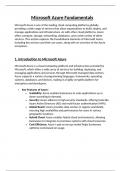
Microsoft Azure Fundamentals: Complete Study Guide for Cloud Exam Success
Prepare for your cloud computing exams with this Microsoft Azure Fundamentals study guide! This comprehensive document provides an in-depth overview of Microsoft Azure, covering key services and features essential for understanding how Azure works in the cloud environment. Whether you’re a beginner or revising for an exam, this guide will help you master the fundamental concepts, including the core services and functionalities that Azure offers. This guide includes: Introduction to Micro...
- Package deal
- Other
- • 7 pages •
Prepare for your cloud computing exams with this Microsoft Azure Fundamentals study guide! This comprehensive document provides an in-depth overview of Microsoft Azure, covering key services and features essential for understanding how Azure works in the cloud environment. Whether you’re a beginner or revising for an exam, this guide will help you master the fundamental concepts, including the core services and functionalities that Azure offers. This guide includes: Introduction to Micro...
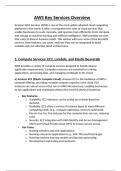
AWS Key Services Overview: Complete Study Guide for Cloud Exam Success
Unlock your cloud computing potential with this AWS Key Services Overview study guide! This comprehensive document breaks down the essential AWS services you need to understand for cloud computing exams, covering Amazon Web Services (AWS)’ most important offerings. From computing power to storage, security, and more, this guide explains how each AWS service works and its role in a cloud environment. Perfect for exam preparation or a deep dive into AWS services, this guide includes: Amazon E...
- Package deal
- Other
- • 7 pages •
Unlock your cloud computing potential with this AWS Key Services Overview study guide! This comprehensive document breaks down the essential AWS services you need to understand for cloud computing exams, covering Amazon Web Services (AWS)’ most important offerings. From computing power to storage, security, and more, this guide explains how each AWS service works and its role in a cloud environment. Perfect for exam preparation or a deep dive into AWS services, this guide includes: Amazon E...
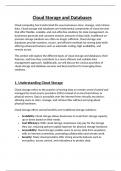
Cloud Storage and Databases: Complete Study Guide & Exam Prep – Everything You Need to Know
Get ready for your exams with this comprehensive guide on Cloud Storage and Databases! This document provides a thorough breakdown of the essential concepts, tools, and technologies involved in cloud-based storage and databases, helping you understand the various options and solutions in the cloud ecosystem. Whether you’re studying for an exam or looking to deepen your knowledge of cloud storage, this guide has you covered with: Cloud Storage Overview: Learn about the different types of clo...
- Package deal
- Other
- • 7 pages •
Get ready for your exams with this comprehensive guide on Cloud Storage and Databases! This document provides a thorough breakdown of the essential concepts, tools, and technologies involved in cloud-based storage and databases, helping you understand the various options and solutions in the cloud ecosystem. Whether you’re studying for an exam or looking to deepen your knowledge of cloud storage, this guide has you covered with: Cloud Storage Overview: Learn about the different types of clo...
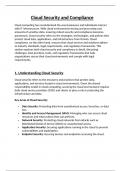
Cloud Security and Compliance: Complete Guide for Exam Success – Study Notes & Insights
Master Cloud Security and Compliance with this comprehensive study guide! This document covers the essential principles of security and compliance in cloud computing, ensuring that you're fully prepared to tackle exam questions on this critical topic. With detailed insights, real-world examples, and exam-specific tips, you’ll gain a solid understanding of how organizations secure their cloud environments and meet regulatory requirements. Topics covered include: Cloud Security Basics: ...
- Package deal
- Other
- • 7 pages •
Master Cloud Security and Compliance with this comprehensive study guide! This document covers the essential principles of security and compliance in cloud computing, ensuring that you're fully prepared to tackle exam questions on this critical topic. With detailed insights, real-world examples, and exam-specific tips, you’ll gain a solid understanding of how organizations secure their cloud environments and meet regulatory requirements. Topics covered include: Cloud Security Basics: ...
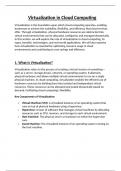
Virtualization in Cloud Computing – Complete Study Guide & Exam Prep
Want to ace your exams on Virtualization in Cloud Computing? This detailed study guide covers everything you need to know about virtualization technology and its role in enabling cloud computing. With a focus on the essential concepts, you’ll gain a deeper understanding of how virtualization makes cloud environments scalable, flexible, and efficient. The guide includes: Introduction to Virtualization: Understand the fundamental concepts of virtualization, how it works, and its importance in...
- Package deal
- Other
- • 8 pages •
Want to ace your exams on Virtualization in Cloud Computing? This detailed study guide covers everything you need to know about virtualization technology and its role in enabling cloud computing. With a focus on the essential concepts, you’ll gain a deeper understanding of how virtualization makes cloud environments scalable, flexible, and efficient. The guide includes: Introduction to Virtualization: Understand the fundamental concepts of virtualization, how it works, and its importance in...
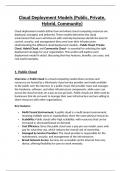
Cloud Deployment Models: Public, Private, Hybrid, Community – Complete Exam Guide & Study Notes
Ace your exams with this comprehensive guide to Cloud Deployment Models! This document covers all the essential deployment models in cloud computing: Public, Private, Hybrid, and Community Clouds. It’s an ideal study companion for understanding the various ways cloud computing environments are deployed, helping students grasp the advantages and differences of each model. The guide includes: Public Cloud: Learn how public clouds are offered over the internet to the general public, with examp...
- Package deal
- Other
- • 8 pages •
Ace your exams with this comprehensive guide to Cloud Deployment Models! This document covers all the essential deployment models in cloud computing: Public, Private, Hybrid, and Community Clouds. It’s an ideal study companion for understanding the various ways cloud computing environments are deployed, helping students grasp the advantages and differences of each model. The guide includes: Public Cloud: Learn how public clouds are offered over the internet to the general public, with examp...
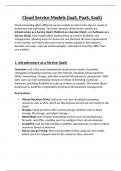
Cloud Service Models Explained: IaaS, PaaS, SaaS – Complete Study Guide & Exam Prep
Prepare for your exams with this in-depth guide on Cloud Service Models! This document breaks down the three core cloud service models: IaaS, PaaS, and SaaS, providing students with everything they need to know. Perfect for exam prep or understanding cloud architecture, this guide covers: IaaS (Infrastructure as a Service): Learn how IaaS provides virtualized computing resources and the benefits it offers to businesses. PaaS (Platform as a Service): Dive into how PaaS enables developers to b...
- Package deal
- Other
- • 6 pages •
Prepare for your exams with this in-depth guide on Cloud Service Models! This document breaks down the three core cloud service models: IaaS, PaaS, and SaaS, providing students with everything they need to know. Perfect for exam prep or understanding cloud architecture, this guide covers: IaaS (Infrastructure as a Service): Learn how IaaS provides virtualized computing resources and the benefits it offers to businesses. PaaS (Platform as a Service): Dive into how PaaS enables developers to b...
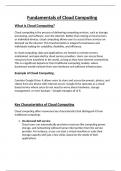
Master the Cloud Computing – Exam Guide & Study Notes
Looking to ace your Cloud Computing exams? This comprehensive guide covers everything you need to know about the Fundamentals of Cloud Computing. Designed to help students grasp the core concepts of cloud technologies, this document breaks down essential topics in easy-to-understand language, including: Cloud Computing Overview: Understand what cloud computing is and how it works. Cloud Service Models: Dive into IaaS, PaaS, and SaaS with detailed explanations. Cloud Deployment Models: Learn...
- Package deal
- Other
- • 7 pages •
Looking to ace your Cloud Computing exams? This comprehensive guide covers everything you need to know about the Fundamentals of Cloud Computing. Designed to help students grasp the core concepts of cloud technologies, this document breaks down essential topics in easy-to-understand language, including: Cloud Computing Overview: Understand what cloud computing is and how it works. Cloud Service Models: Dive into IaaS, PaaS, and SaaS with detailed explanations. Cloud Deployment Models: Learn...

Complete Data Structures & Algorithms Study Pack and Q&A for Exam (30 Documents)
Master Data Structures & Algorithms with this 30-document study pack. Covers arrays, linked lists, sorting, searching, recursion, complexity analysis, graph algorithms, trees, hashing, and more. Each topic includes examples and is made easier to understand. A complete guide for efficient learning. Good luck!
- Package deal
- • 30 items •
- String Algorithms: Techniques and Applications with Examples • Other
- Sorting Algorithms: Concepts, Examples, and Applications • Other
- Mathematical Algorithms: Concepts and Applications with Examples • Other
- Greedy Algorithms: Strategies, Examples, and Applications • Other
- Graph Algorithms: Concepts and Applications • Other
- And more ….
Master Data Structures & Algorithms with this 30-document study pack. Covers arrays, linked lists, sorting, searching, recursion, complexity analysis, graph algorithms, trees, hashing, and more. Each topic includes examples and is made easier to understand. A complete guide for efficient learning. Good luck!

Arrays Complete Exam Study Pack (12 Documents)
Master Arrays with this 12-document study pack. Covers array syntax, multi-dimensional arrays, array partitioning and grouping, dynamic arrays, searching and sorting algorithms, and more. Each topic includes examples and is made easier to understand. Perfect for students looking to ace array-related concepts.
- Package deal
- • 12 items •
Master Arrays with this 12-document study pack. Covers array syntax, multi-dimensional arrays, array partitioning and grouping, dynamic arrays, searching and sorting algorithms, and more. Each topic includes examples and is made easier to understand. Perfect for students looking to ace array-related concepts.
